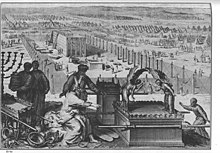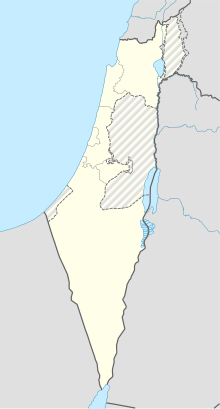Shiloh (biblical city)
 | |
| Location | Samaria |
|---|---|
This article needs additional citations for verification. (August 2009) |
Shiloh was an ancient city mentioned in the Hebrew Bible. Its site is at modern Khirbet Seilun, south of ancient Tirzah and 10 miles (16 km) north of the Israeli settlement of Beth El in the West Bank.[1]
It was the capital of Israel before the first Temple was built in Jerusalem.
The Biblical Period
The site of ancient Shiloh, a city in the Ephraim hill-country, was the religious capital of Israel for 300 years before Jerusalem.[2] Mentioned in the time of the Book of Joshua and Judges, it is north of Beth-El, east of the Beth El–Shechem highway and south of Lebonah in the hill-country of Ephraim (Judg. 21:19). Shiloh has been identified unambiguously with Khirbet Seilun by American philologist E. Robinson in 1838. The location had been established long before by the Roman writer Eusebius and by Nestorius ha-Parhi.
Shiloh is mentioned in the Hebrew Bible as an assembly place for the people of Israel. The "whole congregation of Israel assembled...and set up the tabernacle of the congregation..." (Joshua 18:1), built under Moses' direction from God (Exodus 26) to house the Ark of the Covenant, also built under Moses' direction from God (Exodus 25). According to Talmudic sources, the tent sanctuary remained at Shiloh for 369 years[3] until the Ark of the Covenant was taken into the battle camp (1 Samuel 4:3–5) at Eben-Ezer and captured by the Philistines at Aphek (probably Antipatris). At some point during its long stay at Shiloh, the portable tent seems to have been enclosed within a compound or replaced with a standing structure that had "doors" (1 Samuel 3:15) a precursor to the Temple. The Mishkan left Shiloh when Eli HaCohen died.

Shiloh was the center of Israelite worship. The people assembled here for the mandatory feasts and sacrifices, and here lots were cast for the various tribal areas and for the Levitical cities. This was a sacred act, revealing how God would choose to parcel out the land within the tribes.
Generations later, Samuel was raised at the shrine in Shiloh by the high priest Eli. Samuel began prophesying at a young age and continued to serve in the Tabernacle, but not as a priest because he was not from the family of Aaron.
When the Philistines defeated the Israelites at Aphek, one contingent of Philistines carried the Ark of the Covenant off to Philistia, while another contingent apparently marched on Shiloh and destroyed the shrine.[4] Apparently the Tabernacle was removed before the Philistines arrived, and it was shipped to Gibeon, where it remained until David's time. The Ark was soon returned to Israel, but was subsequently kept in Kiryat-Yearim until David had it brought to Jerusalem. It never returned to Shiloh.
When Solomon died, ten of the tribes seceded and their religious leaders built local worship sites (1 Kings 12:31, 2 Kings 17:29–32, and 2 Chronicles 13:9). At this time, Shiloh may have been revived as a holy shrine; it was home to Ahijah HaShiloni, who announced the secession of the ten tribes after Solomon died.[5]
Isaac b. Joseph Chelo of Aragon, author of "Shibhe di-Yerushalayim", reputedly visited the site in 1334.
The Christian Period
St. Jerome, in his letter to Paula and Eustochius, dated about 392–393, writes: "With Christ at our side we shall pass through Shiloh and Bethel " (Ep.46,13, PL 22, 492). The official church of Jerusalem did not schedule an annual pilgrimage to Shiloh, unlike Bethel. On the contrary, Samuel's feast was held on August 20 in the village of Masephta (Mitzpah). Even the pilgrims seemingly did not visit Shiloh, for the only one that mentions its name—the sixth-century pilgrim Theodosius[disambiguation needed] (ch. 4, CCSL 175, 116)—wrongly locates it mid-way between Jerusalem and Emmaus. The mistaken identification lasted for centuries, as appears, for example, on the Florentine map of 1300, which places Shiloh at Nebi Samwil where the Tomb of Samuel is found. The mosaic map of Madaba wrongly locates Shiloh east of Shechem, omitting to picture the church.
Shiloh assumed messianic attachment amongst Christians due to the verse (Genesis 49:10)—"The scepter shall not depart from Judah, nor a lawgiver from between his feet, until Shiloh comes, and unto him shall the gathering of the people be." Shiloh is believed to refer to Jesus by some Christians. Alternative translations have led others, including some Christians, to different conclusions.[6]
The Muslim Period
In 638 the Muslims conquered the area of Palestine. Muslim pilgrims to Shiloh mention a mosque called es-Sekineh where the memory of Jacob's and Joseph's deeds was revered. The earliest source is el-Harawi, who visited the country in 1173 when it was occupied by the Crusaders, wrote: "Seilun is the village of the mosque es-Sekineh where the stone of the Table is found". Yaqut (1225) and el-Quarwini (1308, Marmardji, 94–95), write similarly.
Archaeology
Archaeological excavations have shown that the place was already settled in about the 19th-18th centuries BC. (Middle Bronze II or MB II, otherwise known as MB IIB according to the Albright school); however, it is not mentioned in any pre-biblical source. There is a tel and many impressive remains from the Caananite and Israelite eras, until the 8th century BC. During the following 12 centuries Shiloh is solely noted as a station on sojourners' routes, usually having only its religious-historical significance to offer. Archeological excavations have revealed remains from the Roman and Persian as well as early and late Moslem periods. An impressive glacis has been located and pottery, animal remains, weapons and other objects have been recovered.
Soundings were first made in 1922 by Aage Schmidt. A Danish team led by H. Kjær (overseen by W.F. Albright) excavated for three seasons between the years 1926-32. A probe was done by Sven Holm-Nielson and Marie-Louise Buhl in 1963. An extensive excavation was done by Israel Finkelstein during the years 1981-84.
Finkelstein's work established eight strata, ranging from Middle Bronze II-Byzantine. A massive wall is attributed to the Middle Bronze III (MB IIC) stage, preserved at a height of 24 ft and width up to 18 ft, with an extensive glacis (with a supporting wall). The Iron I (Israelite) remains yielded a pillared two storey public building near the top of the tel, the earliest attributed to Israelites. Collared rim storage jars and some cultic items were found in these buildings, pointing to usage as part of a cultic complex. More than 20 silos were uncovered from this era, included one with carbonized wheat. The destruction layer evident throughout the tel may have occurred in the wake of the Philistine victory at Eben-Ezer.
One of the more intriguing finds was that of a heap of pottery outside the city wall before[when?] the advent of the Israelite culture. This pile of pottery was the remnant of a number of animal sacrifices, which were tossed over the wall after completion of the ritual and then buried. This find points to a sacral status of Shiloh during the Canaanite period, a status adopted by the Israelites. The top of the tel, where Finkelstein supposes that the tabernacle would have been placed, is now exposed bedrock, offering no clues concerning Israelite worship (aside from the adjacent storage complex).
The site was abandoned, according to Carbon14 measurements researched by Finkelstein around 1050 BCE, and then sparsely repopulated during the Iron II period. Jeremiah's admonition, "Go now to my place that was in Shiloh", in the course of his temple sermon would have occurred during this era (Jeremiah 7:12). More substantive villages emerged in Roman and Byzantine periods.
During August–September 2006 archaeological excavations were carried out adjacent to Shiloh’s tel. A team led by the Archaeological Staff Officer for Judea and Samaria in Israel's Civilian Administration Antiquities Unit, performing a clean-up operation at Shiloh this summer, a belated continuation to a previous 1998 dig, discovered the mosaic floor of a large Byzantine church which was probably constructed between 380 and 420 AD.
Excavations from 2006 to 2007, carried out adjacent to and just south of Tel Shiloh, exposed elaborate mosaic floors as well as several Greek inscriptions, one explicitly referring to the site as the "village of Shiloh".
Three Byzantine basilicas have now been uncovered.[7] The length of one, excavated by H. Kjær in the late 1920s, is 40 meters. The width, also measured externally, is 14.10 m, but a 6.40 m wide room adjoins the building on the south side. This church had three naves, and 12 bases and two beautiful Corinthian capitals (62 cm high and 72–61 cm wide) are preserved. Their appearance recalls the well-known fourth-century style, with separate leaves revealing the ribbing of the back leaves, and a smooth leaf under the corner.
A structure discovered in the Summer of 2006 lies under a Muslim free-standing structure known as Walli Yetaim. It seems to have suffered problems of water drainage in its western section despite the installation of run-off pipes and troughs. It appears that the solution was to raise the level of the church and the laying of a new mosaic floor. It was the older, original floor at the lower level that was revealed this summer. The mosaic contains geometric designs, a cross, flora representations and three inscriptions, one, a dedication of a bench, the second, a salute to the residents of Seilun and the third, a general wish for good tidings. Another discovery of an addition to one of the basilicas occurred in 2013.
Modern Shiloh

Shiloh became an Israeli Settlement in 1978 when a group of Jewish-Israeli settlers affiliated with the Gush Emunim movement settled the location to assert revenant rights. In 1979 the Israeli government officially authorized Shiloh's status as a recognized village. At the end of 2008, the population of the village was approximately 2300.[8] The community contains educational institutions, grocery, a Hesder yeshiva (combining military service and advanced Talmudic studies), sports fields, a pool and several synagogues, one built as a replica of the Biblical Tabernacle.
Biblical figure
Shiloh is mentioned in the Hebrew Bible in Genesis 49:10 as part of the benediction given by Jacob to his son Judah. It could be a figure, perhaps the Messiah, or a place, as mentioned later in Judges and also in Jeremiah 41:5. A resident of Shiloh was the prophet Achiyah mentioned in I Kings 14.
See also
References
- ^ "Shiloh, Israel's Capital for 400 Years, Being Uncovered," Gil Ronen, July 28, 2010, Jerusalem Post.
- ^ LaMar C. Berrett, D. Kelly Ogden, Discovering The World of The Bible, page 94 (Grandin Book Company, 1996). ISBN 0-910523-52-5.
- ^ "Zevachim 118B". Mechon-mamre.org. Retrieved 2013-08-17.
- ^ 1 Samuel 4:4–5, Psalms 78:60 and Jeremiah 7:4
- ^ "1 Kings 14:6–16". Mechon-mamre.org. Retrieved 2013-08-17.
- ^
 Ripley, George; Dana, Charles A., eds. (1879). The American Cyclopædia.
Ripley, George; Dana, Charles A., eds. (1879). The American Cyclopædia. {{cite encyclopedia}}: Missing or empty|title=(help) - ^
Alliata ofm, Eugenio (December 19, 2000). "Discussion: 34. Selo, where the ark stayed - (Kh. Saylun)". Jerusalem: Studium Biblicum Franciscanum. Retrieved 2009-03-15.
{{cite web}}: Cite has empty unknown parameter:|month=(help); Unknown parameter|coauthors=ignored (|author=suggested) (help) - ^ http://www.cbs.gov.il/population/new_2010/table3.pdf
- Finkelstein, Israel, et al. Shiloh: The Archaeology of a Biblical City. Tel Aviv, 1993.

